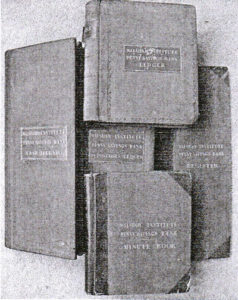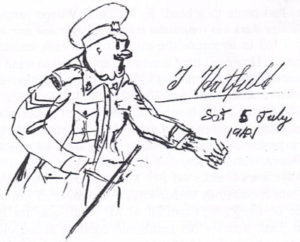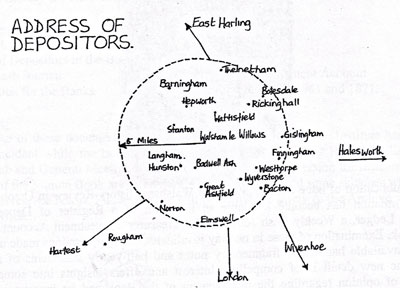The Walsham Institute Penny Savings Bank (A clarification of Walsham History Group Review No.59)

Since the publication of issue number 59 of the Walsham History Group Review in October 2011, further information has become available in the form of a Register of Depositors, a Depositors ’ Ledger, a Weekly Cash Journal, The Treasurer’s Investment Account and the Minute Book. Examination of these in no way invalidates the interpretations made using the previously available handful of fragmentary notes and half-yearly statements of account. However the new detail is of compelling interest and offers insights into some strong differences of opinion regarding the management of the Bank and its investment policy which resulted in the closure of The Institute Penny Savings Bank and the opening of the new Walsham Penny Savings Bank in 1862.
The Register of Depositers is excellent in that it identifies each of the 182 persons who made deposits in the original bank from 1859 until its closure in 1862 and the 298 depositers who made use of the new bank from 1862 until its closure in 1876. Two thirds of the depositors in the first bank failed to sign up for the new second bank. Those using the second bank included one gentleman, one pensioner, eight married women, four widows, nine spinsters, a policeman, a maltster, a baker, a horse clipper, a relieving officer, shoemakers, carpenters, drapers and their apprentices, four servants, a fishmonger and eighteen labourers. (While this may appear a large number of working men, it is worth noting that William Hatten, on his 490 acre farm at Sunnyside, employed 26 labourers and 9 boys.) However 178 of the 298 depositors are recorded as ‘infants’, ‘babes in arms’ and ‘minors’, i.e. below the age of 21. Included here are the children of landowners and professional families although their parents banked elsewhere !
Walter Steward, a shoemaker’s apprentice, usually banked one shilling every month from January 1864 and withdrew his capital together with 14½d. interest in 1868. Harry Durrant, a minor aged 9, withdrew a total of nearly £4 in 1876 after regular deposits of 6d. to 1/- (one shilling) over a period of thirteen years. Charles Hurrell, a fishmonger from Wattisfield, accumulated £11 over a period of five years with monthly deposits of between 2/- and 5/-. Widow Charlotte Jaggard, a dressmaker in Wattisfield Road, aged 42 and with three children, deposited £20 in 1864; by 1876 it was worth over £25.
While the majority of depositors were Walsham residents, people in other villages used the facility of the Penny Savings Bank. The map shows that most of these were within a five mile radius of Walsham, those with a home address at some greater distance had no doubt accepted employment here for a period of time:
Frances Mitson, a single woman from Rougham; Joseph Watson, a draper’s apprentice from London; Charlotte Hunt, a married woman from East Harling.
The seventeen rules governing the management of the Bank, which were unanimously adopted at the opening meeting of 19th April 1859, mirrored exactly “the principles and systems of the Bury Athenaeum Penny Bank”, are printed in full on the inside cover or each customer‘s deposit book. Rule 10 states…
“ All investments shall be made in the names of three Managers, as Trustees, in the Bury Savings Bank, as long as the same can be made available’.
The next meeting, held 21st November 1859, records total deposits of “One hundred and ninety three pounds, two shillings and 8 pence, of which one hundred and sixty pounds is deposited in Messrs Oakes Bevan & Co Bank in Bury St Edmunds”.
The meeting also resolved…
“that the 10th Rule be suspended and that the present as well as future Investments be continued and made in the Bank of Messrs Oakes Bevan & Co’.
By May 1861 a total of £375 had been deposited with Messrs Oakes, Bevan & Co.
In 1860 the Committee approved an advance of £110 to secure a mortgage on some cottages and eight acres of land for Elias Bloomfield of Barningham. He agreed to pay about £8 each year to cover the interest charges. A further cash advance of £50 was made in 1863 and the whole mortgage was redeemed in 1876. Mortgage advances were also made on properties of John Proctor of Walsham, William Cotton of Hepworth, John Bullock of Wattisfield and William Oxborrow of Stanton in the sums of £250 in 1864, £210 in 1868, £100 in 1870 and £30 in 1871 respectively.
From October 1861 deposits of £25 to £30 were made quarterly to the Bury Savings Bank except for the period June 1865 and January 1868 when none were made. There were three purchases totalling nearly £400 of 3% Consolidated Annuities or Consols in April 1869, May 1874 and December 1874, the latter purchase made possible by withdrawing £50 from the Bury Savings Bank. It is this record of investment based on Rule 10 whioh caused the schism in the bank leading to its closure in 1862 and its almost immediate reopening.
We have already seen how Rule 10 which required investment to be made in the Bury Savings Bank was suspended in November 1859 allowing money to be deposited with Messrs Oakes, Bevan & Co Bank and to be advanced as a mortgage on property. In July 1861 a special meeting was convened…
“ to consider whether all investments have been made in conformity with Rule 10′.
It was proposed by F.Maitland Wilson of Langham Hall and seconded by Hooper John Wilkinson, a J.P. and County Magistrate of Walsham Hall…
“that all investments of the funds of this Bank be made in the Bury Savings Bank as directed by Rule 10′.
An amendment was then proposed by Mr. John Miller, brewer, maltster and farmer of 70 acres, and seconded by Walton Kent, General Practitioner…
“that a special meeting of the Managers be called for the purposes of considering the rules of the Bank with regard to Investments and making such amendment to the rules generally as may be deemed expedient“.
The original proposition was withdrawn and the amendment carried.
A further meeting on 6th August saw Messrs Wilson and Wilkinson renew the proposal of July that Rule 10 no longer be suspended; it was carried unanimously. It was further resolved that a Committee should be formed to report on the proposition of interest payments at 2½ % and making all investments in the Bury Savings Bank. The Committee made their report to the meeting of 1st October 1861 but consideration of the report was deferred again to the next General Meeting. In the meantime the Treasurer was requested to…
‘invest the funds of the Bank in his hands from time to time in the Bury Savings Bank, as he shall think proper.’
By 27th January 1862 matters had come to a head! E. Maitland Wilson proposed that…
‘the establishment of a Post Office Savings Bank has superseded the necessity for and met the objectives of this bank’.
Members voted by 7 to 3 to terminate the affairs of the bank and to wind up its affairs in accordance with Rule 17. However, the Committee appointed to wind up the affairs of the bank claimed at a meeting 14th February 1862 that the resolution passed at the previous meeting was not carried in accordance with Rule 17.
A rival meeting was held on 3 rd March 1862. It was chaired by John Miller, the brewer and maltster, and unanimously accepted the proposal of John King, a solicitor living in Palmer Street, and William Colson, a farmer of 73 acres, unanimously…
“that a Penny Bank be established forthwith under the name and style of Walsham le Willows Penny Savings Bank“.
The final meeting of the old Bank took place on 24th March 1862. It resolved that all the books of the Bank be given into the custody of Mr. Miller, Treasurer of the new Walsham Penny Savings Bank. A vote of thanks was carried to Mr. Martineau for his assistance throughout the affairs of the Bank and for his handsome conduct at the close. (He had requested to be allowed to write a cheque for £6.10s4d. to cover the deficiency in the accounts at the close.)
The Bank operated now for a further thirteen years until November 1875 when three managers signed a proposal…
‘to consider terminating the business of the bank as a consequence of the facilities offered by the Post Office and other sources for carrying out the objects for which the Penny Bank was established’.
This was carried unanimously in accordance with Rule 17. On the 22nd February 1876 the Committee reported that the several mortgages were repaid and all funds converted into money….depositors would be required to attend the Bank Room at 3.00 pm on 6th March to receive their deposits.
On 20th March 1876 The Accountant produced balance sheets showing a surplus of £27.15s.0½d. following payment of Depositors‘ balances. Dr. Short proposed that £10 be given to Mr. Sones as a mark of appreciation of his services as Secretary and Accountant. He also proposed that the balance of £17.15s. 0½d. be given to the Institute for enlarging the Supplemental Library and establishing a Reading Room for the Working Classes with recommended affiliation to the recently formed Suffolk County Village Club Society.
I would like to think that the Committee of Managers of the original Bank set up in 1859 were impressed by the tenacity of the new Managers who reopened the Bank in 1862, the success of their varied investment strategy and their generous subscription to the Reading Room and Library for the Working Classes on the closure of the Bank.
Acknowledgements
Richard Martineau; Register of Depositors in the Banks; Depositors’ Ledger; Weekly Cash Journal; Treasurer’s Investment Account; Minute Book for the Banks; Census returns for 1861 and 1871.
Postscript

The storage of these documents for many years in cupboards in The Institute has not been without incident while the building served variously as a Reading Room, Billiard Room, Youth Club and General Meeting Room before its sale and conversion for residential use. In the back of the Minute Book are a few scraps of handwriting and some sketches which speak for themselves, see below. Future storage will be within the safety of the Archive of the Bury Record Office.


